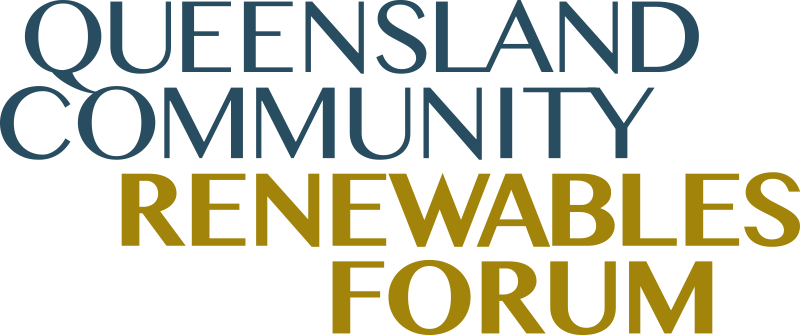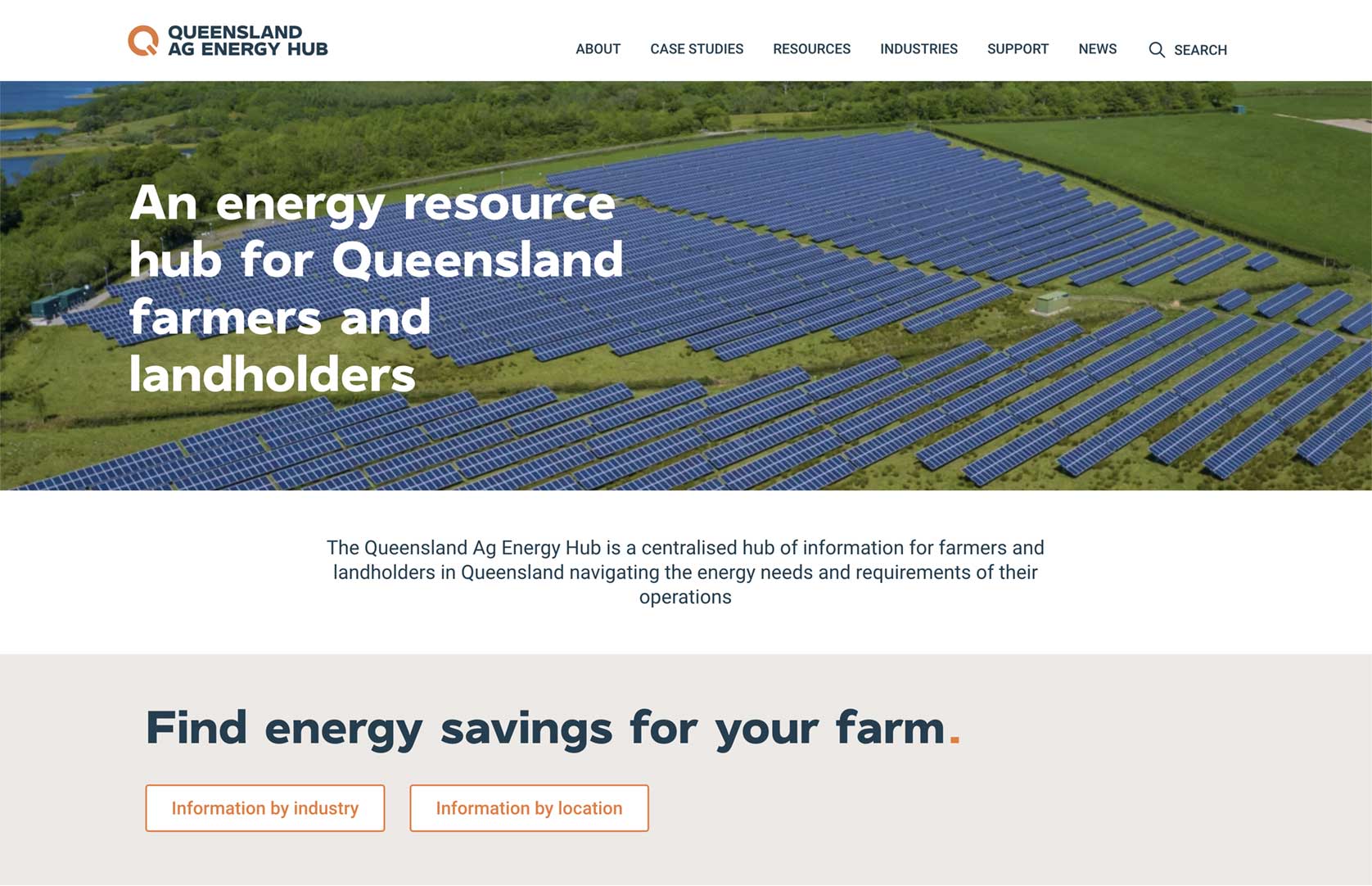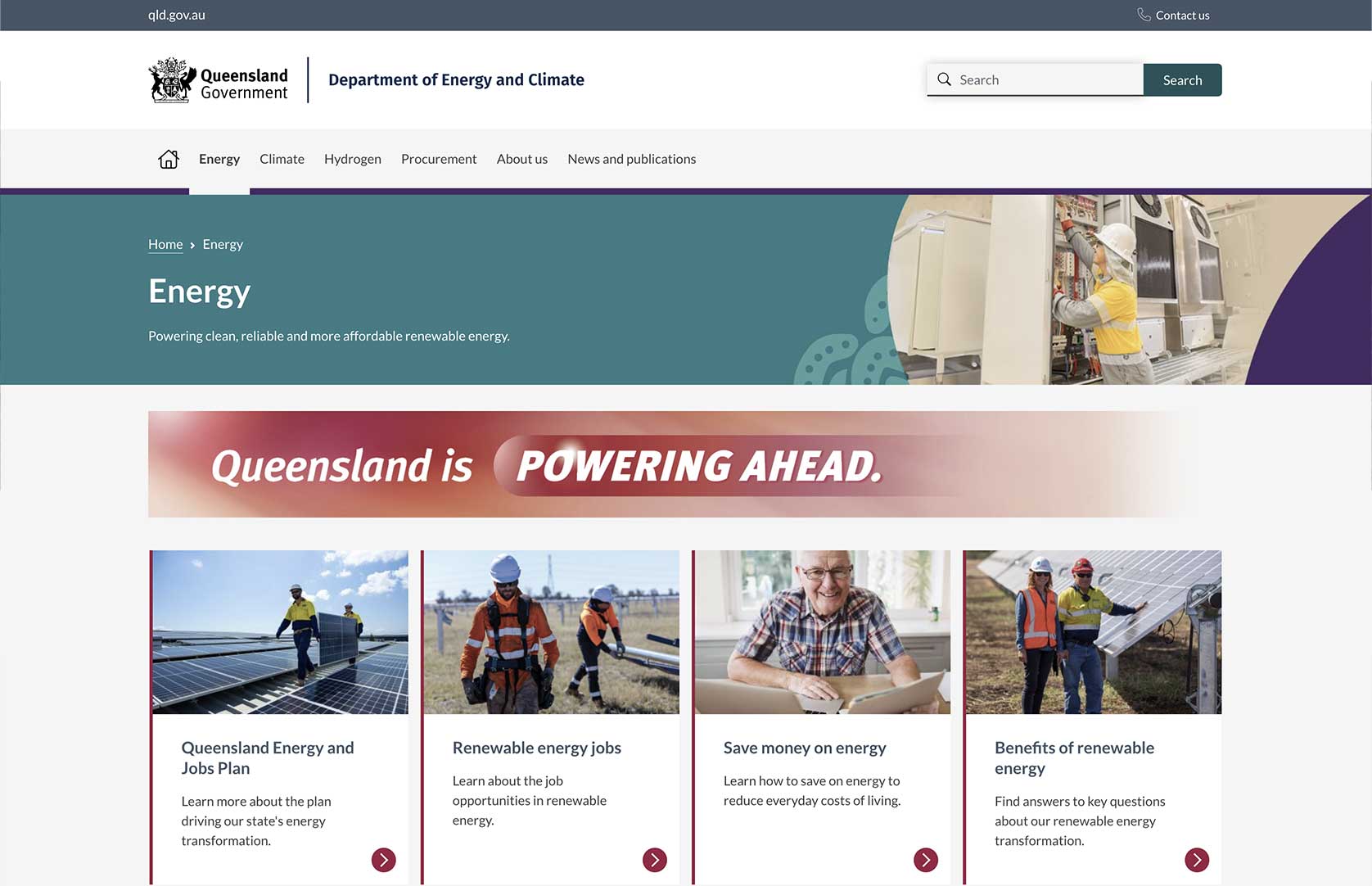Ask us anything
Queensland is well placed to seize a once-in-a-lifetime opportunity to create jobs, business opportunities and sustainable energy as part of the global transition to renewables.
Our emissions reduction goals will require considerable large-scale development but are supported by an abundance of clean energy sources, leading government policy in the form of the Queensland Energy and Jobs Plan and a welcoming investment climate.
Communities are at the centre of this opportunity as we strive for balanced economic, environmental and socially responsible outcomes. Queensland Community Renewables Forums are intended to enable a shared understanding of the interests of communities, First Nations people, agricultural producers and the renewable energy industry.
Below are some of the most common questions people ask about renewable energy and the energy transition. We’ve also included links to leading, up-to-date and trustworthy resources.
Frequently asked questions
Click a topic below to sort questions.
- All
- Big Picture
- Community Benefits
- Compensation
- Logistics
- Regulatory
- Renewable Energy Zones
- Renewables & Agriculture
“Large-scale” refers to renewable energy projects that are significant in size and capacity, often involving substantial infrastructure and investment. These projects are designed to produce large amounts of electricity, usually for distribution through the national grid, rather than for individual or small-scale local use.
Some examples of large-scale renewable energy projects include:
- Wind farms
- Solar farms
- Pumped hydro
- Battery storage
Large-scale renewable energy development is a cornerstone of Australia’s strategy to reduce dependence on fossil fuels and achieve a sustainable energy future, contributing to energy security, economic growth and environmental goals. Large-scale projects also provide:
- Economies of scale, making renewable energy more cost-competitive.
- Grid stability, contributing significantly to the stability and reliability of the electricity grid by providing large quantities of clean energy.
The Queensland Government Department of Energy and Climate provides further information on why we are transitioning to renewable energy and the relevant elements of the Queensland Energy and Jobs Plan.
No. As the Queensland Government does not own the sun or the wind, royalties are not collected from renewable energy proponents.
The Queensland Energy and Jobs Plan and Infrastructure Blueprint outlines the pathway to transform the Queensland energy system to deliver clean, reliable, and affordable power for generations.
By 2035, the Queensland SuperGrid will have around 25 gigawatts (GW) of large-scale wind and solar generation – this is eight times the 3GW of operational large-scale wind and solar capacity that was operational in September 2022, when the Plan was released.
Through the Queensland Renewable Energy Zone Roadmap, 12 proposed Renewable Energy Zones (REZs) have been identified to deliver an additional 22 GW of renewable energy by 2035.
At least 6GW of long duration energy storage, including pumped hydro, is planned to store generated energy and assist in meeting demand.
Publicly owned coal-fired power stations will be repurposed into clean energy hubs that provide critical system strength, storage, firming and/or host new generation.
The distribution network will also integrate an additional 7.4GW of new rooftop solar, 5.8GW of battery storage and the ability to service a potential 1.6 million electric vehicles by 2035.
A Renewable Energy Zone (REZ) is a designated area identified by the Queensland Government as being particularly suitable for large-scale renewable energy projects. They are a key tool for ensuring the energy transformation is coordinated and provides positive and responsible outcomes for communities, developers and other stakeholders.
REZs are strategically selected based on several key factors, including:
- Resource availability: Areas with abundant renewable energy resources such as high solar irradiance, strong and consistent winds, and suitable sites for hydroelectric power.
- Grid infrastructure: Proximity to existing electricity transmission infrastructure, which facilitates the integration of new renewable energy projects into the grid with minimal additional investment.
- Land availability: Regions with suitable land for the development of large-scale renewable energy projects, considering both the availability of land and the potential for minimal environmental and social impact.
- Community support: Zones where there is a supportive local community and stakeholders, which helps in the smooth implementation of renewable energy projects.
- Economic potential: Areas with the potential for economic development and job creation through renewable energy projects.
The REZ Roadmap outlines 12 potential renewable energy zones across Queensland. View the REZ Roadmap here.
The Roadmap is a framework for connecting around 22GW of renewable energy to the grid. It was developed in line with the Queensland Energy and Jobs Plan and will help the state meet its targets of:
- 50 per cent renewable energy by 2030
- 70 per cent renewable energy by 2032
- 80 per cent renewable energy by 2035.
REZs provide a number of benefits and efficiencies, including:
- Grid efficiency: Concentrating renewable energy projects in designated zones helps optimise the use of existing grid infrastructure and can reduce the need for extensive new transmission lines.
- Environmental protection: By carefully selecting zones, the government aims to minimise environmental impacts and avoid ecologically sensitive areas.
- Economic growth: REZs promote regional economic development by attracting investment, creating jobs, and supporting local industries.
- Streamlined development: REZs help provide certainty for energy developers by pre-identifying suitable areas, which speeds up the approvals process and reduces the time and costs associated with project development.
No. Each REZ will be unique and subject to its own planning and investigation of potential impacts and benefits for local communities, landholders, the environment, renewable energy companies, and all Queenslanders. Each renewable energy project will still undergo a comprehensive engagement process and follow a rigorous planning and project approval pathway.
Potential impacts from renewable energy projects on agricultural activities will vary from project to project and property to property. While renewable energy developers will aim to minimise impacts as much as possible, it is important that a landholder considers all potential impacts from a proposed renewable development on their property, both now and into the future, and ensures that these are adequately compensated as part of any negotiated agreement.
It is important to consider both potential construction and operational impacts and seek appropriate professional expertise where required as part of this consideration. The Queensland Farmers Federation’s Queensland Renewable Energy Landholder Toolkit is an excellent resource for landholders who may be considering hosting a renewable energy project and negotiating a subsequent agreement.
Potential environmental impacts are considered as part of the State and Federal government assessment processes a renewable energy proponent must go through to gain the necessary approvals required to construct and operate a renewable energy development. Many different environmental factors are considered as part of these processes and these may often address concerns that landholders may have in this regard.
If landholders have specific concerns regarding environmental impacts on their property or feel that additional consideration may be required, they are encouraged to raise these issues with the relevant renewable energy developer.
Potential environmental impacts, including impacts to water resources and overland flow, are considered as part of the State and Federal government assessment processes a renewable energy proponent must go through to gain the necessary approvals required to construct and operate a renewable energy development. However, if landholders have specific concerns regarding potential impacts to water resources and/or overland flow on their property and feel that additional consideration may be required, they are encouraged to raise these issues with the relevant renewable energy developer.
Through the Local Energy Partnerships framework, state and local governments are partnering with industry and peak bodies in regional Queensland so that:
- local voices and choices are shaping how the renewable energy transformation takes place
- local benefits of renewable energy development are flowing to regional communities and local businesses.
For a progress update of actions under Local Energy Partnerships and the Queensland Energy and Jobs Plan, read the Community Partnerships and Enabling Frameworks (May 2024).
This framework was a result of community feedback on Queensland’s energy transformation.
The Queensland Government in April this year said it would develop a mandatory and nation-leading code of conduct for the renewable energy industry.
The code of conduct, which will be co-designed with various stakeholders, will ensure locals benefit first and foremost from the renewable energy jobs boom and that developers conduct themselves in a manner which is consistent and respectful.
It will do this by ensuring renewable energy developers engage genuinely with landholders and communities when developing, building and operating new generation and storage projects.
Yes. Queensland’s renewable energy sector needs technically skilled workers to design, install and operate renewable energy systems.
It needs trades people and technicians to operate and maintain large scale wind, solar and battery assets as well as installers for home and business rooftop solar and batteries.
Queensland also needs highly skilled corporate professionals for community liaison, commercial trading and project management roles, just to name a few.
Learn more about the types of jobs in the Queensland Government’s Future Energy Jobs Guide.
A: Solar:
Solar Farms can be constructed quickly, given the modular assembly process. While there are variations to construction timeframes for a range of factors, including terrain, weather, labour availability and landholder considerations.
A solar farm will typically be in operation for between 30-40 years. At the end of a solar panel’s life, there is still a lot of value in the panel. A typical solar panel is made up of 16 different mined minerals, such as silica, titanium, cadmium and copper. Many of these minerals can be reused and reprocessed through a recycling process. As an example, copper is 100 per cent recyclable, with 98 per cent of all copper mined to date, still in use today.
Given this residual value in a solar panel past its production life, solar panels are typically sent to a recycler who can strip recover valuable minerals and other valuable materials that can be recycling, such as aluminium steel.
A: Wind:
The construction timeframe largely depends on the project size and may take several months to up to two to three years depending on the scope and scale of the project.
The designed, operational lifespan of a wind farm in Australia is typically about 25-30 years although there are opportunities to repower a project by replacing old turbines to extend the life of the project as a whole.
At the end of their operational life about 85-95 per cent of a wind turbine (by mass) is made of recyclable materials. However, there is currently limited solutions for the reuse or recycling of wind turbine blades and this is a focus of current research and development.
Renewable energy developers will generally aim to minimise impacts during construction and operation so as to comply with relevant approvals and improve or maintain their social licence. Many proponents also complete relevant management plans for traffic and transport activities.
Specific concerns a host landholder may have should be incorporated into the negotiation of any relevant agreement. If a neighbouring landholder or community member has a concern then they are encouraged to contact the relevant renewable energy proponent.
Most wind turbines require maintenance at least once every two years however some turbines require more maintenance than others. In addition to the maintenance requirements, wind farms require regular safety and operational inspections and monitoring so as to comply with regulatory requirements and ensure ongoing safety and efficiency of the project.
Maintenance and operational requirements for solar farms also vary. Regular cleaning of the panels is required so as to maintain efficiency and land maintenance (weed and vegetation) is also required so as to ensure safe and unimpeded access and operation. As with wind, regular safety and operational inspections are required to check the physical condition of the panels, mounting systems and electrical components.
Agreements to host a renewable energy project are a voluntary agreement between the landholder and the renewable energy proponent. In negotiating an agreement, it is important that a landholder considers all potential impacts from the renewable development on their property, both now and into the future, and ensures that these are adequately compensated.
There are many things that a landholder should consider as part of the negotiation process and the Queensland Farmers Federation’s Queensland Renewable Landholder Energy Toolkit is an excellent resource for landholders about to commence this process.
Landholders are also encouraged to seek appropriate legal and other professional advice as required.
In reaching agreement to host a renewable energy project, agreed compensation should be sufficient to ensure potential impacts to the existing land use and enterprise are appropriately mitigated. Therefore, providing that any agreement has been negotiated and structured appropriately, it is not expected that hosting a project will negatively affect property value.
In fact, there are examples in renewables and other industries where property values have actually increased as a result of the income or compensation stream provided as a result of hosting a project.
The availability of compensation for landholders neighbouring renewable energy developments, including transmission infrastructure, varies depending on the type and location of the infrastructure and the likelihood of impact to the neighbouring property.
For example, Powerlink’s SuperGrid Landholder Payment Framework provides for payments to neighbouring or adjacent landholders depending how much of their land is within a 1km radius of any new transmission infrastructure.
If a landholder is concerned about impacts to their property and feel that they may be entitled to compensation, they are encouraged to contact the relevant renewable energy developer for the project.
Hosting a renewable energy project in Queensland is completely voluntary and there is no ability for a developer to ‘force’ a development on a landholders property where the landholder does not wish for it to occur.
As negotiations and the development of an agreement for a renewable energy project is a voluntary commercial arrangement between the renewable energy developer and the landholder, there is no mandated legal requirement for developers to pay landholders legals costs. However, given the nature of the agreement and the fact that it is voluntary on behalf of the landholder, landholders are encouraged to consider all costs associated with development of the agreement and ensure that any compensation received adequately covers all impacts.
The Queensland Energy and Jobs Plan identifies actions to work with communities to develop a First Nations best practice guide for the energy transition and to ensure cultural heritage outcomes are reflected through REZ planning and development.
A number of native title groups in Queensland have also entered into Indigenous Land Use Agreements with renewable energy developers which set a framework for various activities such as indigenous stewardship, First Nations supply and procurement services and indigenous participation.
Cultural Heritage Management Plans for renewable energy projects are also normally developed in conjunction with Traditional Owners to cover the project lifecycle so as to ensure cultural heritage is appropriately considered, preserved and managed.
The Queensland Indigenous (Aboriginal and Torres Strait Islander) Procurement Policy (QIPP) is also aimed at supporting Indigenous businesses to successfully tender for State Government contracts and assist in developing a diverse, sustainable Indigenous business sector.
How does the government ensure that renewable energy projects comply with environmental regulations?
Environmental regulations and obligations are considered as part of the State and Federal government approval processes that apply to renewable energy development and there are investigation and compliance powers under both State and Federal legislation to assist in the enforcement of environmental requirements. Landholders and community members are able to raise any concerns they may have with the relevant renewable energy developer in the first instance and then the relevant government department if they remain dissatisfied.
A development approval is required for any large-scale renewable energy development in Queensland. For solar farms, assessments are generally undertaken by the relevant local government whereas wind farms are assessed by the Queensland Government through the State Assessment and Referral Agency (SARA).
In addition to the development approval, renewable energy projects in Queensland must comply with a number of other State government legislative acts and requirements. Where projects may have impacts on matters of national environmental significance, proponents may also have to apply for approval under the Federal Environment Protection and Biodiversity Conservation Act 1999 (EPBC Act).
Further information on the approvals and assessment processes for large scale renewable energy development in Queensland is available from the Business Queensland website at this link. The Queensland Renewable Energy Council (QREC) has also mapped both State and Federal approvals pathways and they can be downloaded here.
The time taken for a project to receive the necessary approvals can vary significantly and depends on a number of factors such as complexity, location, potential impacts and scale. Simpler projects could complete the approvals process in 6-12 months whereas more complex projects that involve application under the EPBC Act could take up to 3 years from application.






